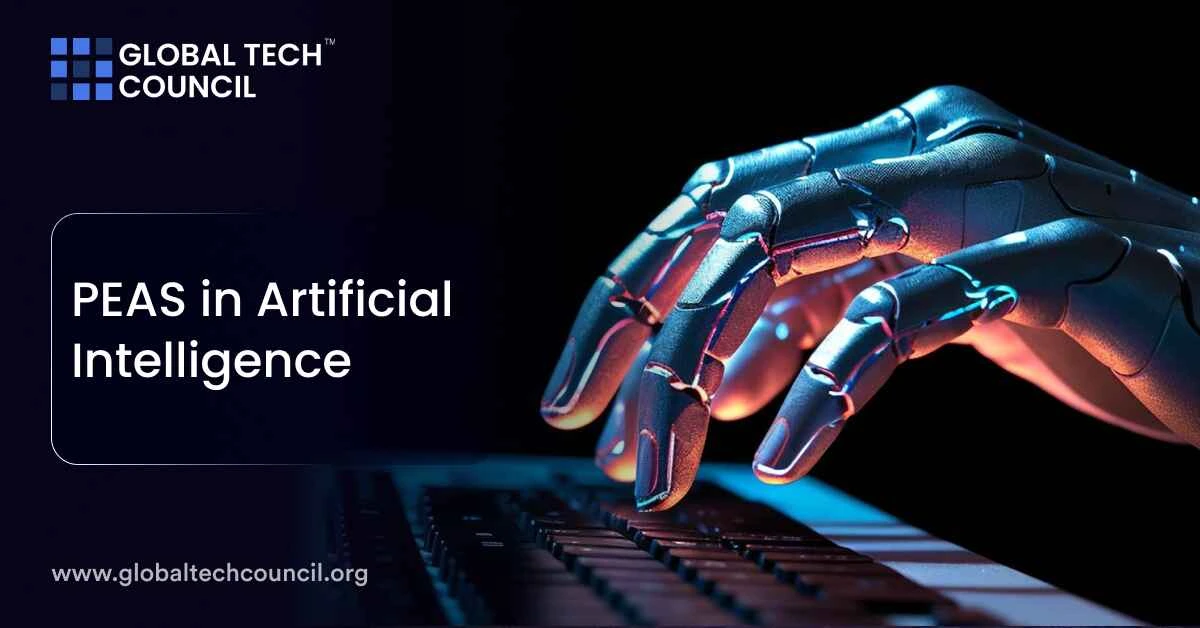
Artificial Intelligence (AI) uses different methods to define and build smart systems. One such model is the PEAS framework, which stands for Performance Measure, Environment, Actuators, and Sensors. This approach offers a straightforward way to describe how an AI agent interacts with its surroundings and achieves its targets.
What is PEAS?
PEAS is a method to outline the structure of AI agents, especially those working independently in various situations. It acts like a guide, detailing the agent’s features and its interaction with the external environment. By dividing the agent’s parts and goals into four distinct areas—Performance Measure, Environment, Actuators, and Sensors—PEAS helps in understanding and building AI systems more clearly.
PEAS Framework Components
a. Performance Measure
This part checks how well an AI agent performs. For example, in a navigation tool, it could be the shortest route. In a game-playing AI, it might be the number of wins or score achieved. The performance measure outlines what success looks like for the agent in a given task.
b. Environment
The environment covers everything the agent interacts with. It can be physical, like a robot in a factory, or digital, like a program managing files on a computer. Clearly defining the environment is important because it affects what the agent can and cannot do.
c. Actuators
Actuators are tools the agent uses to perform actions. For robots, these could be wheels, arms, or hands. For software, actuators might be functions that send messages or change digital files. They help the agent make changes in the environment based on decisions it makes.
d. Sensors
Sensors collect data from the environment. For robots, these could be cameras, microphones, or temperature gauges. For software, sensors might include data inputs from websites or user interactions. Sensors allow the agent to understand its surroundings and respond accordingly.
Examples of PEAS in Action
a. Self-Driving Cars
Performance Measure: Safe driving, comfortable ride, and time efficiency. Environment: Roads, traffic lights, pedestrians, and other cars. Actuators: Steering, acceleration, braking, and signaling. Sensors: Cameras, LIDAR, radar, GPS, and motion detectors.
In this case, the self-driving car uses its sensors to understand the road and its actuators to move, steering clear of obstacles while aiming for the best performance.
b. AI in Customer Support
Performance Measure: Quick response, user satisfaction, and information accuracy. Environment: Online chat or phone systems. Actuators: Text response or voice replies. Sensors: Customer messages, user data, and context clues.
Here, the AI system interacts with users via a digital platform, using sensors to understand queries and actuators to reply with relevant information.
Importance of the PEAS Framework
Using PEAS helps define what an AI system can do and what it needs. It’s especially useful during design and development, making sure the AI agent meets its intended functions. By breaking down the tasks and tools into these categories, developers can better address issues like perception, decisions, and actions.
For instance, in healthcare, an AI system might use PEAS to monitor patient health and suggest treatments. The performance measure could be patient health outcomes, the environment would include hospital settings, actuators could be decision-support systems for doctors, and sensors could be patient monitoring equipment.
Challenges in Using PEAS
While PEAS is helpful, it’s not without difficulties. One main challenge is correctly defining the performance measure. The agent’s success often depends on the situation, making it hard to set a single, clear metric. Also, environments can be unpredictable, needing the agent to adjust quickly. Plus, combining sensors and actuators that work reliably in various conditions is a complex task.
For example, in autonomous cars, unexpected obstacles or unpredictable driver actions can complicate the situation, making it hard for the AI to maintain good performance. Similarly, in language processing, understanding subtle meanings in human speech and providing suitable responses can be tough for AI systems.
Conclusion
The PEAS framework offers a way to create and analyze AI agents by breaking down their interaction with the world into specific parts. Knowing each element of PEAS is essential for building effective AI systems, whether they are physical robots, virtual assistants, or any other type of smart agent. This framework not only helps in designing AI systems but also in checking how well they perform in different situations. By using the PEAS framework thoughtfully, developers can build AI agents that work effectively, making it a key tool in the field of artificial intelligence.